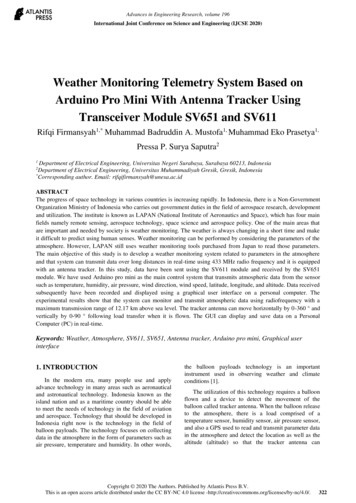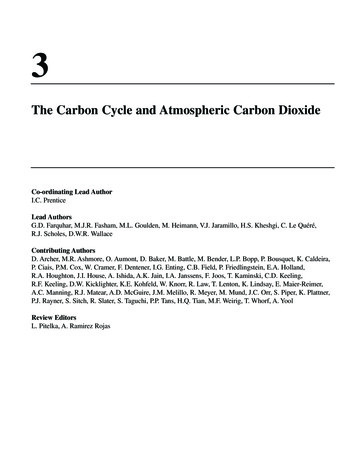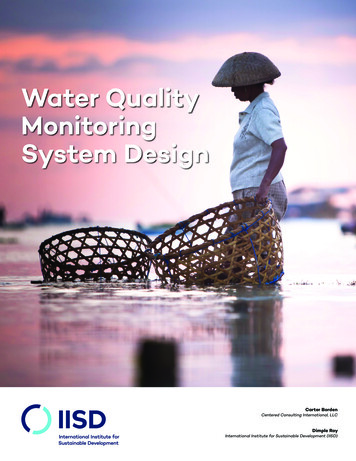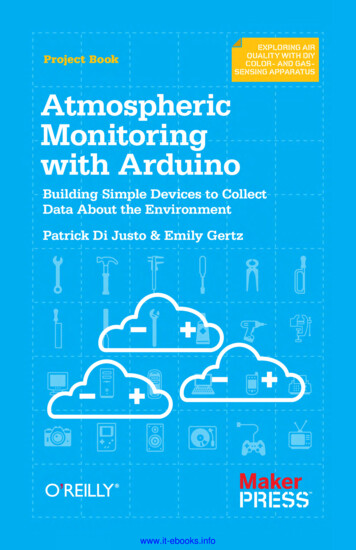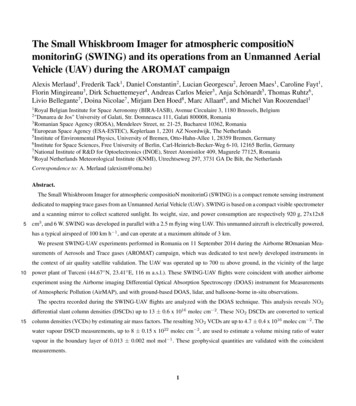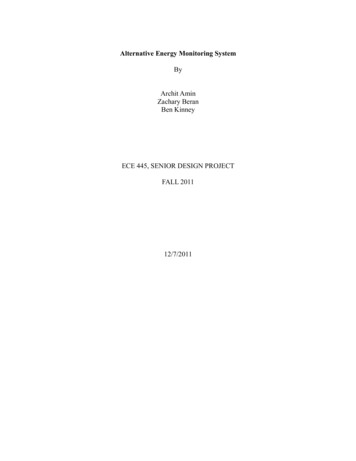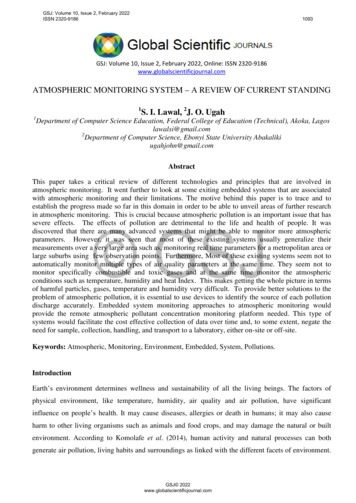
Transcription
GSJ: Volume 10, Issue 2, February 2022ISSN 2320-91861093GSJ: Volume 10, Issue 2, February 2022, Online: ISSN C MONITORING SYSTEM – A REVIEW OF CURRENT STANDING11S. I. Lawal, 2J. O. UgahDepartment of Computer Science Education, Federal College of Education (Technical), Akoka, Lagoslawalsi@gmail.com2Department of Computer Science, Ebonyi State University Abakalikiugahjohn@gmail.comAbstractThis paper takes a critical review of different technologies and principles that are involved inatmospheric monitoring. It went further to look at some exiting embedded systems that are associatedwith atmospheric monitoring and their limitations. The motive behind this paper is to trace and toestablish the progress made so far in this domain in order to be able to unveil areas of further researchin atmospheric monitoring. This is crucial because atmospheric pollution is an important issue that hassevere effects. The effects of pollution are detrimental to the life and health of people. It wasdiscovered that there are many advanced systems that might be able to monitor more atmosphericparameters. However, it was seen that most of these existing systems usually generalize theirmeasurements over a very large area such as, monitoring real time parameters for a metropolitan area orlarge suburbs using few observation points. Furthermore, Most of these existing systems seem not toautomatically monitor multiple types of air quality parameters at the same time. They seem not tomonitor specifically combustible and toxic gases and at the same time monitor the atmosphericconditions such as temperature, humidity and heat Index. This makes getting the whole picture in termsof harmful particles, gases, temperature and humidity very difficult. To provide better solutions to theproblem of atmospheric pollution, it is essential to use devices to identify the source of each pollutiondischarge accurately. Embedded system monitoring approaches to atmospheric monitoring wouldprovide the remote atmospheric pollutant concentration monitoring platform needed. This type ofsystems would facilitate the cost effective collection of data over time and, to some extent, negate theneed for sample, collection, handling, and transport to a laboratory, either on-site or off-site.Keywords: Atmospheric, Monitoring, Environment, Embedded, System, Pollutions.IntroductionEarth’s environment determines wellness and sustainability of all the living beings. The factors ofphysical environment, like temperature, humidity, air quality and air pollution, have significantinfluence on people’s health. It may cause diseases, allergies or death in humans; it may also causeharm to other living organisms such as animals and food crops, and may damage the natural or builtenvironment. According to Komolafe et al. (2014), human activity and natural processes can bothgenerate air pollution, living habits and surroundings as linked with the different facets of environment.GSJ 2022www.globalscientificjournal.com
GSJ: Volume 10, Issue 2, February 2022ISSN 2320-91861094Furthermore environmental health and the soundness of a human habitat for safe living is crucial aswith the development of industry, the environment conditions worsened day by day, human’s demandfor understanding surrounding environment information is more and more urgent and more alsoincreasing tendencies for technological development and its impact on surrounding environmentrequires better understanding of relationship between elements within it. Short and long turnmodifications on environment caused by such changes must be recorded before any analyzing processcould be performed. Seceroval. (2019), Argue that monitoring and recording large time series of dataand making them available for studying are the key roles of environmental monitoring systems andbeing able to store unchanged and reliable information of monitored parameters poses great challengewhich must be solved. Real time data collecting in different environments brings new perspective inscientific analysis. Whether such data are used to understand better living environment or to predict andproduce warning of potential hazard occurrence, different solutions are developed.At the international Level, Amegah, & Agyei-Mensah (2016), stated that Environmental monitoring hasbeen a tool to assess environmental conditions and trends, support policy development and itsimplementation, and develop information for reporting to national policymakers, international forumsand the public. Over the past decade, only a few countries of Europe and Central Asia have been able tomaintain existing monitoring activities. The monitoring of urban air pollution — an important humanhealth risk — is poor in many cities of the subregion and Africa. Solid and hazardous waste monitoringis weak and industrial emissions are also not well monitored, reducing the effectiveness of policyinstruments such as emissions charges and fines. Monitoring of transboundary air pollution also needsstrengthening. Moreover, many European and African countries lack uniform national methodologiesacross different monitoring areas, and their classification systems are often incompatible withinternational standards.For the Nigerian case, Olowoporoku et al, (2011) observed that since 1988 the Nigerian Governmenthas introduced environmental legislation aimed at reducing the atmospheric impact of various sourcesof pollution. Emphasis has often been placed on mitigating pollution from the oil and gas industry.However, various studies indicate significant ambient air pollution from other sources due to vehiculartraffic growth in urban areas, increased reliance on petrol and diesel fueled generators for electricitysupply in homes and other public facilities, uncontrolled open incineration of waste and major thermalpower stations within the city limits.Furthermore, Nigeria as a rapidly industrializing developing country with abundant natural resources, alarge human population of about 200 million people and diverse sensitive ecosystems that must bemanaged in a sustainable manner, has put in place since 1988 institutional and regulatory frameworkfor environmental protection and natural resources conservation. The country has participated activelyin most international forum and initiatives on the environment since the 1992 United NationsGSJ 2022www.globalscientificjournal.com
GSJ: Volume 10, Issue 2, February 2022ISSN 2320-91861095Conference on the Environment (UNCED); and has ratified major Multilateral EnvironmentalAgreements (MEAs) including those on chemicals and wastes.Against all these background many reasons have been advanced for the lack of an effectiveenvironmental enforcement programme. One of the reasons often cited is the Existence of ill-equippedinstructional framework – An example is the FEPA which is clearly lacking the full or evenmanageable complement of resources to function effectively. Without functional institutions effectiveprotection of the environment will remain a theoretical goal which may get a lot of lip service fromgovernment functionaries without the much needed propensity to reality perform their task (Idowu,2000)Understanding Atmospheric MonitoringAccording to U.S. Environmental Protection Agency (2021), Monitoring is a general term for on-goingcollection and use of measurement data or other information for assessing performance against astandard or status with respect to a specific requirement. With regards to EPA's air quality regulatoryrequirements; there are two basic types of atmospheric monitoring with two different functions:The fist is the ambient air quality monitoring. This type of monitoring collects and measures samples ofambient air pollutant to evaluate the status of the atmosphere as compared to clean air standards andhistorical information. The second is the stationary source emissions monitoring which collects anduses measurement data at individual stationary sources of emission. Ambient air quality monitoring isrequired to determine whether a geographical region or area is meeting the National Ambient AirQuality Standards (NAAQS) for criteria pollutants. Stationary source emissions monitoring is requiredto demonstrate that a source is meeting the requirements in Federal rules or in State rules that are partof a State Implementation Plan (SIP). Most monitoring that stationary sources must conduct is relatedto specific regulation resulting from the Clean Air Act (CAA).Types of Atmospheric Monitoring DevicesGas Detection monitoring devices can be classified in one of three ways. A fixed system refers to amonitoring system permanently installed in the workplace (stationary). The detecting sensor may behard wired, or use wireless signals to a central reporting station. Most will come with an auditory alarmsystem. The type of sensor used will be defined by the system, as well as the gas or gases to bedetected. Fixed gas detection can be used indoors, as well as having outdoor use as a perimeter monitorwith chemical manufacturing and petrochemical sites.Portable Gas Detection refers to gas detectors which are worn or carried by an individual. Typicallybattery operated, portable monitors are used for toxic or combustible gas detection, as well as foroxygen deficiency monitoring in confined spaces.GSJ 2022www.globalscientificjournal.com
GSJ: Volume 10, Issue 2, February 2022ISSN 2320-91861096Area Monitoring Detection offers the benefits of a multi-gas fixed system in a transportable unit. Theseunits are designed for team protection or area surveillance for short-term work where fixed gas systemsare not suitable.Review of Recent Atmospheric Monitoring Systems TechnologiesMadhuri Patiletal, (2016) in a study titled Recent Literature on Weather Monitoring Systems classifiedmonitoring systems based on technology to include the following: wireless sensor network basedsystem (WSN) , Satellite based system, Microcontroller Based system, Arduino based system, GSMbased system, Radar based system, Zigbee based system, Prediction based system, Sensor BasedSystem, and Camera Based System.Wireless Sensor Network Based SystemAccording to Ashenafi & Haghani (2014), Wireless Sensor Networks (WSNs) includes various sensorsdistributed spatially with the capacity of communication, processing and computing. The data is sensedand transmitted to the base-station regularly. Here, in real time manner, data is processed and managed.One proposed framework conquers the above restriction by organization of WSN base for differentclimate advance utilizing virtual sensor and overlay idea. Checking climate information and givingSaaS and interpersonal organization cataclysm cautions in light of choice ID3 system and give cloudvalidation utilizing secure shell. Similar work gives a conditional summary on WSN with Internet ofbothers based on PARASENSE plan. A good arrangement is made for sending continuous applicationsand for conveying it.Satellite Based SystemAccording to Kalsi (2008), Satellite information is progressively being utilized as a part of conjunctionwith routine meteorological perceptions in the concise investigation and traditional climate gauge toconcentrate data. CanSat is a scale reproduction of the outline, creation and dispatch of a genuinesatellite. It is described by minimal effort of usage. Climate observing is the utilization of science andinnovation to foresee the condition of the climate for a given area. The CanSat assembled can bedispatched and used to monitor neighborhood climate for a range, in a sparing way. Authors haveexplained on our work on this paper. In this study, the climate satellite is a kind of satellite that isbasically used to screen the climate and atmosphere of the Earth. Weather satellite pictures are alwayshelpful in checking the volcanic powder cloud.GSJ 2022www.globalscientificjournal.com
GSJ: Volume 10, Issue 2, February 2022ISSN 2320-91861097Microcontroller Based SystemSusmithan and Sowmyabala (2014), in their study, clams that the basic point of a work based onmicrocontroller is to manufacture an implanted framework to plan an air checking framework whichempowers the saw of climate parameters in an industry. This type of work includes different sensorslike Gas sensors, temperature sensors, and dampness sensors which were observed with the use ofARM 9 LPC1768 microcontrollers. The following framework utilizes a complex circuit developed withARM 9 processor. Embedded C programming is used. Scheduling is done with the use of JTAG inassociation with ARM 9 processor.Arduino Based SystemThrough a specific framework it can naturally gather the data about stickiness and temperature.Through this framework authors can naturally gather the data about stickiness and temperature. Thepoints of interest are put away in a database and as per present and past information authors can deliverthe outcomes in graphical way in the framework. (Karthik and SurajThapa, 2015).GSM Based SystemIn GSM based systems, a gadget for ongoing climate observing is displayed to screen the constanttemperature, environmental weight, relative dampness and air’s dew point temperature through suchsystem which is utilizing simple and advanced parts. Digital signals are obtained from analog signalsand database is altered according to the program designed for displaying user-friendly outcomes interms of pressure on a display. (Lo Conti, et. al. 2014).Radar Based SystemIn Radar based systems like, the creators introduced a technique that coordinates both of theinformation sources to give strategic and arranged climate radar. (Kelly, Kronfeld and Rand, 2000).ZIGBEE Based SystemTo create sensor networking and weather station monitoring system without human mediation, utilizingWireless ZigBee Technology, Zigbee is the most recent remote climate checking method. The previouschecking frameworks of Weather Monitoring System are manual that time. (Nisha et. al, 2015).GSJ 2022www.globalscientificjournal.com
GSJ: Volume 10, Issue 2, February 2022ISSN 2320-91861098Prediction Based systemsIn a prediction based system, Mettlach et. al, (2008) proposed a methodology for monitoring transientclimate conditions based on semantic and geospatial coherent cross-disciplinary. In this, demonstrationof individuals driven detecting system is given to improve the accuracy of the system and thelegitimacy of information collected using regular sensor is affirmed. Similarly, Mattlach et. al. assessedthe conventional climate armada as an asset for atmosphere monitoring. The wave soul range, which allNDBC climates floats routinely report hourly. It contains a lot of data with respect to the starting point,quality and term of sea tempests. Such estimations are delivered from basic accelerometers originatingfrom an adult, settled innovation. SWAP is another one method which will execute as an operationalsun based observing instrument for space climate forecasting. The LYRA information will makeprofitable sun powered checking data, for agent space climate now throwing and testing. Similarly inanother prediction based system, the control outfit figure with starting condition instability, is handy yetunder dispersive. To enhance the unwavering quality of the outfit gauges, the control group issupplemented with 1) annoyed side perspective limit conditions; or, representation blunderrepresentation utilizing either 2) stochastic active soul backscatter or 3) stochastically botheredparameterization propensities. Multi-physics and a stochastic active fundamental backscatterarrangement are utilized in a similar system to speak to model instability in a meso-scale troupeconjecture framework utilizing the Weather Investigation and Forecasting model.Sensor Based SystemIn a recent work, Mittal et. al. planed to distinguish the topographical ranges for sun based and windvitality eras with ease. There framework depends on remotely worked framework with sensors, whichaccumulates climate data and transmits measured qualities to the ground. The framework is worked bybattery, and is required to keep running with an expanded life period. Static sensor hubs and submergedsensor web are connected in ecological verification in a novel study. By consolidating adding a sensorsystem and a technique of distributed computing, the submerged sensor bid can be improved. Theclimate station is designed recently which has a gathering of sensors for measuring wind pace andbearing, air temperature, relative dampness and precipitation. A snowfall connector can be continuingthe precipitation gage that permits estimation of the water fulfilled of snow amid winter months.DCOMP is a novel system having a set up to keep running on sensors with comparative channelsettings and has been effectively practiced on most current meteorological imagers. This standardmakes DCOMP especially profitable for air research. Correlations with the Moderate ResolutionImaging Spectro-radiometer (MODIS) gathering 5 dataset are utilized to figuring the execution ofDCOMP.GSJ 2022www.globalscientificjournal.com
GSJ: Volume 10, Issue 2, February 2022ISSN 2320-91861099Thakur et.al., (2016), in their recent work ,wind sensor, wind direction sensor, humidity andtemperature sensor are used for sending the real time data on Thing Speak cloud Which can be easilyobserved and analyzed to authorized person or may be publically open. It uses Raspberry Pidevelopment board used earlier by many authors for user-friendly works .Arm 7 is an efficientprocessor which is generally used for real time operation in many applications.Camera Based SystemWith a unique sort of camera and computerized multi-image photogrammetric framework, it's currentlyconceivable to takeout Digital Elevation Models (DEM) with capturing an image by the camera.Usingsuch strategy; the plane is may not be limited to flight way straightly. And it may go straightforwardlyalong objective region. That postulation presented the work hypothesis of computerized photographicvisibility framework (for short is DPVS), edge of framework, structure of equipment and programmingstream, at last correspondence amongst host and open air cell.(Shital et. al., 2016)Review of Recent Embedded DesignThis system utilizes the embedded design technique and the Arduino platform. According to thedefinition of IEEE, an embedded system is a single-purpose computer built into a larger system for thepurposes of controlling and monitoring the system. A microcontroller can be considered a selfcontained system with a processor, memory and peripherals and can be used with an embedded system.(Only the software needs be added). The majority of microcontrollers in use today are embedded inother machinery, such as automobiles, telephones, appliances, and peripherals for computer systems.These are called embedded systems. While some embedded systems are very sophisticated, many haveminimal requirements for memory and program length, with no operating system, and low softwarecomplexity. Typical input and output devices include switches, relays, solenoids, LEDs, small orcustom LCD displays, radio frequency devices, and sensors for data such as temperature, humidity,light level etc. (GuylèneProulx, 2000.). Embedded systems usually have no keyboard, screen, disks,printers, or other recognizable I/O devices of a personal computer, and may lack human interactiondevice (A Practical Guide to Fire Alarm Systems, 2011). The amount and type of detectors that onechooses for property protection will depend on the owner’s property protection goals, the value of theproperty and the requirements of the owner’s insurance company.Generally, heat detection will be used in all areas that are not considered high value. Here again, one ofthe most common mistakes in fire alarm system application is to provide partial protection of a buildingand expect high performance from the installed systems of any kind. (Fullwikipedia, 2014).Xie Tan ( 2006) developed a system to counter the problems of gas accidents in coal mines andfamily safety from gas usage through the use of a new infrared detection optics principle. TheGSJ 2022www.globalscientificjournal.com
GSJ: Volume 10, Issue 2, February 2022ISSN 2320-91861100infrared optics gas detection was high in detection accuracy, long range service life. It thesystem allowed the passage of infrared signal to the gas intended for measurement whileitsmolecules will absorb the light energy. The absorption relationship followed Lamber-Beer law.In the year 2014, Soundarya, et al, stated that an efficient and smooth working controller isneeded to continuously sense both leakage and level of the gas. And also fast response isrequired when leakage is found and the monitoring system must provide additional leakageinformation which can be used in further processing. The detection system includes Arduinoduemilanove, microcontroller board compatible with ATmega328p coupled with the system is theweight sensor, LCD display, GSM and DC motor.Chen and Jiang, (2008)designed and implemented a GSM-Based Remote Monitoring System.Theon wireless monitoring because the wireless remote monitoring systempaperfocusedhas a wider application. The hardware and software architecture of the system was designedwhere the remote signal is transmitted through GSM network. The system has two parts: themonitoring centerand the remote monitoring station.and a TC35 communication module for GSM.RS232.The computer and the TC35 are connected byThe remote monitoring station consist of a TC35 communication moduleMSP430F149 MCU, a display unit, sensorssoftwareThe monitoring centerconsists of a computerand a data gatheringandprocessingfor GSM, anunit.Thefor the monitoring center and the remote monitoring station were designed using VB.A review of gas leak detection techniques was done by (Puran G. et. al. 2014) with aclassification of leak detection methods in a gas pipeline to monitor the integrity of a pipeline. Interms of mode of operation, (Soundarya ., et al, 2014) settled for the use an Arduino board, whichis quite expensive and bulky. used microcontroller (PIC16F877), which in turn is a soft real timesystem. It is said that “A hard real time system should always respond to an event within thedeadline or else the system fails and endangers human lives but in soft real time system, failingto meet the deadline produces false output and does endanger the human lives.Devahema et al., (2018) in their survey noted that the level of pollution has increased with times by lotof factors like the increase in population, increased vehicle use, industrialization and urbanizationwhich results in harmful effects on human wellbeing by directly affecting health of population exposedto it. In IOT Based Air Pollution Monitoring System the Air Quality is measured over a web serverusing internet and will trigger a alarm when the air quality goes down beyond a certain level, meanswhen there are sufficient amount of harmful gases are present in the air like CO2, smoke , alcohol,benzene and NH3. It will show the air quality in PPM on the LCD and as well as on webpage so thatwe can monitor it very easily.MQ135 sensor which is the best choice for monitoring Air Quality as itcan detects most harmful gases and can measure their amount accurately .The pollution level can beGSJ 2022www.globalscientificjournal.com
GSJ: Volume 10, Issue 2, February 2022ISSN 2320-91861101monitored anywhere using computer or mobile. Install this system anywhere and can also trigger somedevice when pollution goes beyond some level, like it can switch on the Exhaust fan or can send alertAccording to Pan and Zhu (2018), Dust, known as “airborne particles”, refers to solid particles that aresuspended in air (diameter 100 μm). Among them, dust with diameter 2.5 μm, known as “fineparticulate matter”, is referred to as PM2.5. After being inhaled by the human body, PM2.5 can directlyenter the blood through the bronchi and alveoli, which are phagocytized by macrophage. Their longterm stay in the alveoli exerts a negative impact on the human cardiovascular, nervous system, andother organs, posing a threat to people’s health. Consequently, indoor air quality has become a greatconcern.Al Ahasan et al., (2018) stated that now-a-days air pollution is one of the most important concern of theworld. Air pollution may evolve from anthropogenic or natural sources. Air pollutants of atmosphericsubstances like CO, CO2, SO2, NO2, and O3 suspended particulate matter (SPM), repairablesuspended particulate matter (RSPM), and volatile organic compounds (VOCs) have a great effect onthe people health. Most of the major cities in developing countries and most cities of the developedcountries are suffering from it. Thus to develop a real time air quality and pollution monitoring systemis critical. We have developed an Arduino based air pollution detector which combined a small-sized,minimum-cost sensor to an Arduino microcontroller unit. The advantages of the detector, have areliable stability, rapid response recovery and long life features. It is affordable, user-friendly, low-costand minimum-power requirement hardware which is appropriate for mobile measurement, as well ascomprehensible data collection. It has a processing software able to analyze, collected quality data withhigh precision.Husain et al., (2016) In their paper a cost efficient, portable, easily manageable Arduino based devicehas been presented to monitor air quality. The device works by collecting data of quantity of specificharmful gases and the amount of dust present in the air. This device can be located at any place and thedata can be transferred to an Android phone via Bluetooth or simply by connecting the device to aPC/laptop. Data collected by the device from different places can be later examined to make furtherdecisions and analysis about the state of air quality; furthermore, it can also help concerned individualsto act upon it.According to Karami et al., (2018) building performance monitoring could be limited due to the costand inflexibility of hardware and software platforms for data acquisition. This paper describes aportable continuous measurement toolbox which provides a robust, easily extendable, and low-costGSJ 2022www.globalscientificjournal.com
GSJ: Volume 10, Issue 2, February 2022ISSN 2320-91861102setup for indoor environmental quality (IEQ) monitoring and performance assessment. Varioussensors—temperature, relative humidity, illuminance, CO2, VOC, PM2.5, and occupancy—for IEQperformance measurement are included in this toolbox. Arduino Uno boards were connected to thesensors for data acquisition. ZigBee communication protocol was established between an XBee devicefor each Arduino board and an XBee receiver connected to a computer. The toolbox utilized the opensource, agent-based software platform for data communication and analysis. The data collection systemwas calibrated against an accurate data acquisition card. Experiments have been conducted using thetoolbox for assessing IEQ performance in an open computer lab within a commercial building. Thermalcomfort, indoor air quality, and lighting performance have been analyzed based on collected data. Thestudy demonstrated reliability and robustness of the toolbox for continuous monitoring of indoorenvironmental quality.Alvea et al., (2018) stated that Evidence shows that Smart Cities are starting to materialize in our livesthrough the gradual introduction of the Internet of Things (IoT) paradigm. In this scope, crowd sensingemerges as a powerful solution to address environmental monitoring, allowing to control air pollutionlevels in crowded urban areas in a distributed, collaborative, inexpensive and accurate manner.However, even though technology is already available, such environmental sensing devices have notyet reached consumers. In this paper, we present an analysis of candidate technologies for crowdsensing architectures, along with the requirements for empowering users with air monitoringcapabilities. Specifically, we start by providing an overview of the most relevant IoT architectures andprotocols. Then, we present the general design of an off-the-shelf mobile environmental sensor able tocope with air quality monitoring requirements; we explore different hardware options to develop thedesired sensing unit using readily available devices, discussing the main technical issues associatedwith each option, thereby opening new opportunities in terms of environmental monitoring programs.Vijayalakshimi et al. (2016) are of the opinion that “Real Time Weather Monitoring from RemoteLocation Using Raspberry pi” proposed a system for Real time weather monitoring using Raspberry pi,it measure various weather parameters like temperature, light intensity, atmospheric pressure,Gas/smoke level using appropriate sensors interfaced with Raspberry Pi, it uses wireless technology toprovide real time data transfer. The project deals with designing a simple, highly efficient, costeffective and easy to operate Real time weather monitoring system. Using a database to raspberry pithis project can access from anywhere.Rasal and Jaideep, (2016) in their research “Raspberry Pi Based Weather Monitoring System” proposeda system that visualizes the parameters of weather variables. To know the current weather condition atremote location this system is design for. Proposed System will visualize and store various weatherGSJ 2022www.globalscientificjournal.com
GSJ: Volume 10, Issue 2, February 2022ISSN 2320-91861103parameters as given above with the help of sensors interfaced to Raspberry will get all data, SD card onPi stores the collected data as like memory card (Rasal, and Rana, 2010).Gonçalo et al. (2015) in a work titled “An Intelligent Weather Station” presented an intelligent weatherstation for forecasting different variables of weather. To predict and analysis weather var
with atmospheric monitoring and their limitations. The motive behind this paper is to trace and to establish the progress made so far in this domain in order to be able to unveil areas of further research in atmospheric monitoring. This is crucial because atmospheric pollution is an important issue that has severe effects. The effects of pollution are detrimental to the life and health of .

